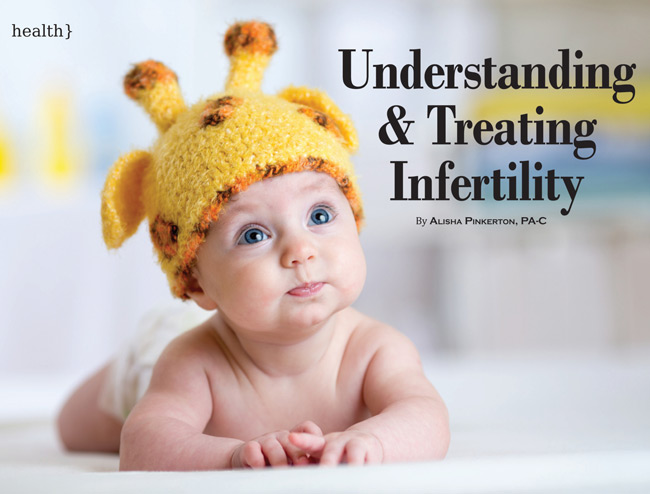Understanding and Treating Infertility

by Alisha Pinkerton, PA-C
Infertility is a problem that many couples struggle with each year. When dealing with infertility it is helpful to understand the basics of the menstrual cycle, available testing and treatment options.
According to UpToDate.com, 85% of couples will conceive within the first 12 months of attempting pregnancy, however the other 10-15% of couples will struggle with infertility. Fertility is the capacity to conceive and produce offspring. Infertility is the inability to conceive after 12 months of regular unprotected intercourse, however, if a woman is older than 35 years of age, infertility is considered after 6 months of trying to conceive without success. Therefore, your age and amount of time having unprotected intercourse without success determines when a diagnostic evaluation is indicated. Other factors may warrant a diagnostic evaluation sooner than 6-12 months regardless of age, such as but not limited to: irregular menses, damaged or blocked fallopian tubes, stage III-IV endometriosis, a family history of early menopause, history of certain cancer treatments and male subfertility.
If you are having difficulty conceiving or are concerned about your fertility, you should talk with your healthcare provider about the plan that is best for you. At the initial visit your healthcare provider will review your history and perform a physical exam. Once this is completed, the appropriate testing will be ordered. Testing should be done in a focused and cost-effective way and should take the couple’s preferences, the duration of infertility, the woman’s age and specific factors revealed through the medical history and physical examination into account.
Basic infertility testing available includes: ovarian reserve testing, hysterosalpingogram, saline infusion sonogram and semen analysis. Other tests may be done to rule out thyroid disorders and high prolactin levels. Androgen levels may be checked in women who have increased hair growth (hirsutism) and/or irregular menses. Ovarian reserve testing is used to help the healthcare provider predict whether the patient can produce an egg or eggs of good quality. This testing may include blood tests, transvaginal ultrasonography or both. A hysterosalpingogram or HSG for short, is a test used to check if the fallopian tubes are open and to assess the shape of the endometrial cavity (the inside part of the uterus). A saline infusion sonogram can also be used to assess the inside part of the uterus. Surgical procedures such as hysteroscopy and laparoscopy may also be warranted.
Once testing is completed, a follow up visit should be scheduled with your healthcare provider to discuss results and treatment options. There are many treatment options available, such as: medications to help women ovulate and assisted reproductive technology (ART). Medications used to induce ovulation may be given to women with irregular menses or no menses at all. Ovulatory dysfunction frequently occurs in women with polycystic ovary syndrome (PCOS), obesity, hyperprolactinemia (increased levels of the hormone prolactin), thyroid disease, eating disorders, extreme exercise and/or weight loss, among other things.
Fertility medications used to induce ovulation are not only used in women with irregular or no menses, they are also used in women without ovulatory dysfunction. In these women, the goal is to produce more than one follicle per menstrual cycle, in turn causing the woman to release more than one egg at a time.
This is referred to as controlled ovarian stimulation (COS) or superovulation.
Medications used for ovulation induction can be taken orally or by injection and can be combined with timed intercourse, intrauterine insemination (IUI) or In-vitro fertilization (IVF). Timed intercourse is the process of timing intercourse appropriately with ovulation. IUI is also timed with ovulation. The IUI process consists of sperm collection from the man prior to the procedure, followed by washing of the sperm with a special solution in the laboratory. The IUI is then completed by passing a small catheter through the cervix and injecting sperm into the inside part of the uterus (endometrial cavity). IVF is the process of surgically removing a woman’s egg(s) from the ovary and combining the egg(s) with the man’s sperm in a laboratory dish. The desired result is formation of an embryo or embryos. If the egg is fertilized and an embryo has formed the embryo will then be transferred into the woman’s uterus. If multiple embryos are formed, more than one embryo may be transferred simultaneously, however, this would be decided by you and your healthcare provider. Remaining embryos may be frozen and used at a later time. One advantage of IVF compared to other treatments, is your healthcare provider can limit the number of embryos transferred, thus reducing the possibility of multiples.
The most common medications used for ovulation induction include clomiphene citrate (CC), aromatase inhibitors (i.e. Letrozole), and gonadotropins. The gonadotropins include FSH, LH, hMG (human menopausal gonadotropin), and hCG (chorionic gonadotropin). Depending on the underlying diagnosis, other medications may be used for treatment, such as medications to help with high prolactin levels (hyperprolactinemia) and high insulin levels (hyperinsulinemia).
Gonadotropins are injectable medications commonly used with IUI and IVF. These medications are used to cause multiple follicles to develop at the same time. Each follicle has the potential to contain a good egg. Many women are concerned this type of treatment will diminish her overall egg supply quicker than with a natural cycle, however, this is not the case. This type of treatment rescues eggs that would have otherwise died off naturally. Fertility medications, like all medications, have potential risks and complications, such as multiple pregnancy. These risks and complications should be discussed with your healthcare provider, prior to initiating treatment.
In summary, if you are having difficulty conceiving or are concerned about your fertility, talk with your healthcare provider to discuss the plan that is best for you.
If you would like more information on this topic please refer to: www.acog.org, www.asrm.org, and www.uptodate.com.
